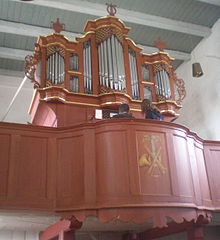Roggensteder Church
The Evangelical Lutheran Roggensteder Church is located in the East Frisian town of Roggenstede ( Dornum municipality ) and was built in the 13th century. It stands on a granite foundation and is made of brick.
history
In the Middle Ages, Roggenstede belonged to the Archdiocese of Bremen and was under the broadcasting area of Ochtersum . The church dates back to the 13th century and was probably built around 1260 to 1270 as a replacement for an older previous church. Originally the interior was closed off in three bays with vaults, which however collapsed around 1670. The west wall was shortened and redesigned as part of this. In 1891 the apse was rebuilt with small bricks.
Building description
The brick church was built on a granite base as a Romanesque hall with a semicircular east apse. The old arched portals with granite embrasures were later walled up. The longitudinal walls on the outside are divided into fields of different sizes in the upper half by pilaster strips . Originally, the long sides each had three high-seated arched windows, corresponding to the three bays that were once there. The shield arches on the longitudinal walls inside and the strong wall pillars still point to the former stone vaults. A special feature is the hagioscope , a medieval leprosy fissure.
The separate bell tower of the closed type dates from the time the church was built and is located on the northeast corner. The bell was given to the community by Count Rudolf Christian in 1627 .
Furnishing
The interior is now closed by a flat wooden beam ceiling. The church's Protestant two-winged written altar dates from the 16th century. It used to be in the Dornum church and was given to the Roggensted parish in 1683 when the large baroque altar was built in Dornum. The late Gothic shrine is still preserved at the back, the back wall of which was painted with sayings in 1582. In 1950 the crowning canopy was removed.
The hexagonal pulpit was made in the 15th century, but changed and repainted in the neo-Gothic style in the 19th century. Represented are Moses and the Evangelists.
Other items of equipment include a crucifix from the first half of the 14th century hanging on the north wall. The Corpus Christi originally hung on a forked cross ; today's transom is a later addition. The so-called hunger or plague cross shows Christ with an emaciated body, protruding ribs and skinny limbs, who has a share in the suffering of people. The baptismal font made of Bentheim sandstone dates from the time the church was built and the Gothic sacrament house in the northeast corner with the original painting and consecration crosses from the beginning of the 15th century. A votive ship has adorned the church since 1680. There is also an epitaph of the daughter of a former pastor from 1722 in the church. A tulip-shaped chalice, which is said to date from 1706, belongs to the altar.
organ
The organ was created by the Esensian organ builder Johann Gottfried Rohlfs from 1827 to 1833 with eight stops on one manual and attached pedal . The instrument was not entirely spared from modifications that were carried out in 1899 and 1953, but were reversed during the restoration by Martin Haspelmath in 1988/89.
|
|
|||||||||||||||||||||||||||||||||||||||||||
Remarks:
- R = register by Johann Gottfried Rohlfs (1827–1833)
- H = register by Martin Haspelmath (1989)
See also
literature
- Hans-Bernd Rödiger, Heinz Ramm: Frisian churches in Auricherland, Norderland, Brokmerland and in Krummhörn , Volume 2. Verlag CL Mettcker & Söhne, Jever (2nd edition) 1983, p. 93.
- Hermann Haiduck: The architecture of the medieval churches in the East Frisian coastal area . 2nd Edition. Ostfriesische Landschaftliche Verlags- und Vertriebs-GmbH, Aurich 2009, ISBN 978-3-940601-05-6 , p. 136 ff .
Web links
- Homepage of the parishes of Westeraccum, Westerbur and Roggenstede
- Harlingerland Church District: Roggensteder Church
- Hartwig Mammen (local chronicle of the East Frisian landscape ): Roggenstede (PDF file; 32 kB)
- Genealogy forum: Roggenstede
Individual evidence
- ↑ a b Hartwig Mammen (local chronicle of the East Frisian landscape ): Roggenstede (PDF file; 32 kB), viewed June 12, 2011.
- ^ A b Gottfried Kiesow : Architectural Guide East Friesland . Verlag Deutsche Stiftung Denkmalschutz , Bonn 2010, ISBN 978-3-86795-021-3 , p. 313 .
- ^ Ingeborg Nöldeke: Hidden treasures in East Frisian village churches - hagioscopes, rood screens and sarcophagus lids - overlooked details from the Middle Ages . Isensee Verlag, Oldenburg 2014, ISBN 978-3-7308-1048-4 , p. 79 f.
- ^ Dietrich Diederichs-Gottschalk : The Protestant written altars of the 16th and 17th centuries in northwest Germany . Verlag Schnell + Steiner GmbH, Regensburg 2005, ISBN 978-3-7954-1762-8 , pp. 135 ff.
- ↑ Gottfried Kiesow: Architectural Guide Ostfriesland . Verlag Deutsche Stiftung Denkmalschutz, Bonn 2010, ISBN 978-3-86795-021-3 , p. 314 .
- ↑ organ on NOMINE eV , seen 12. June 2011.
Coordinates: 53 ° 37 ′ 51.8 ″ N , 7 ° 29 ′ 7.6 ″ E



